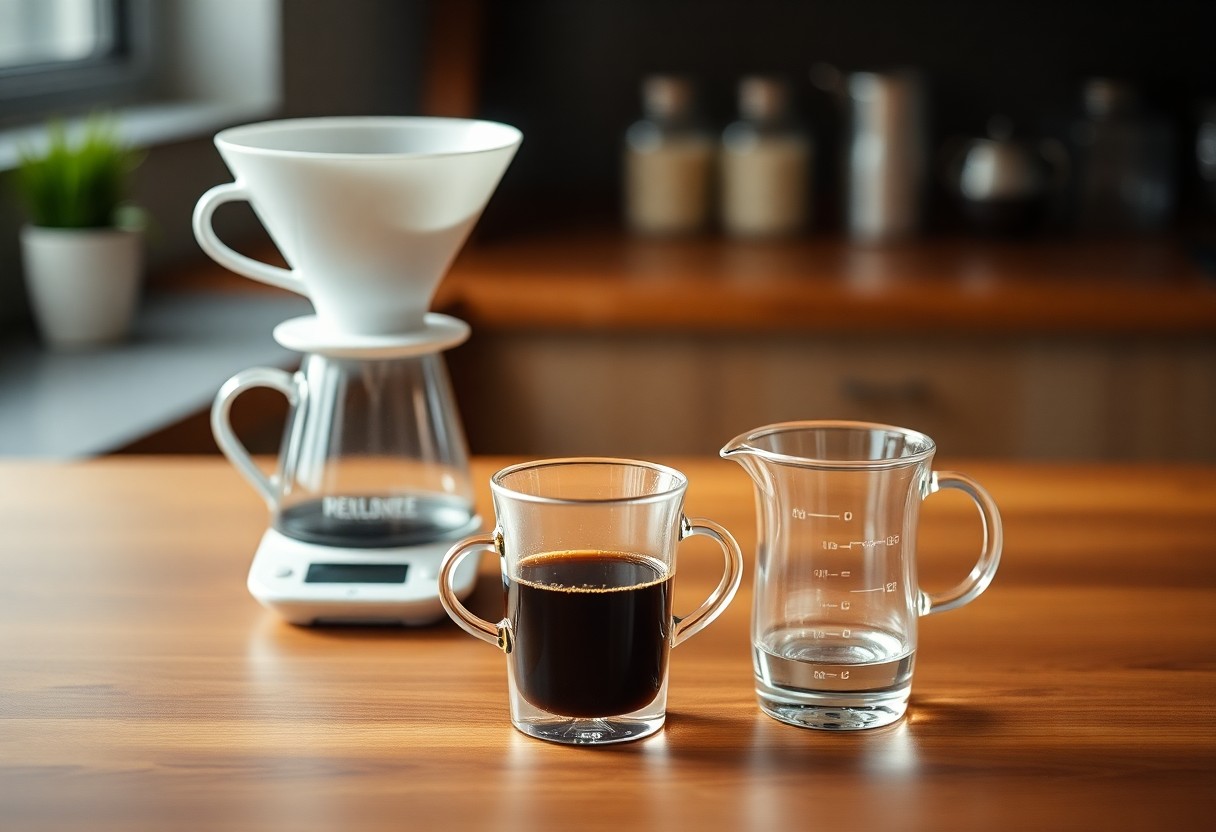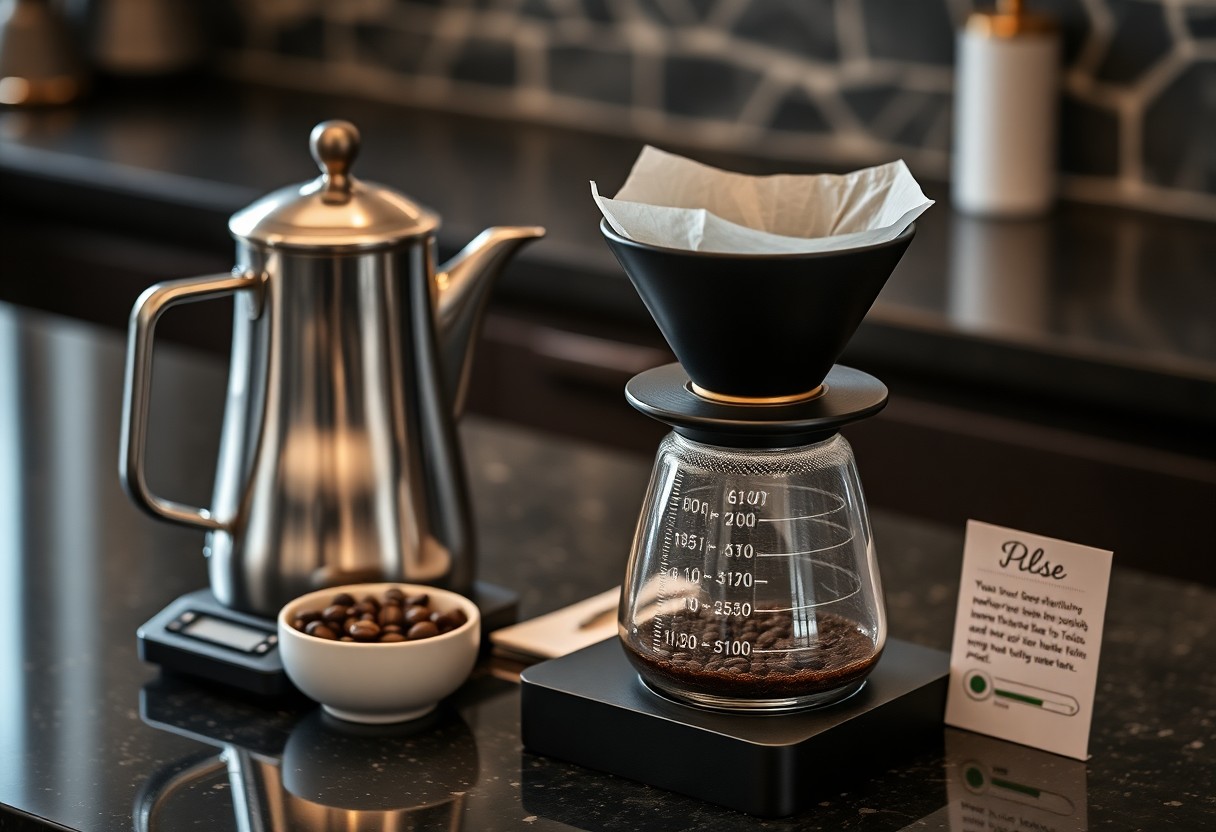With a few simple adjustments, you can transform your pour-over coffee experience through the technique of pulsing. This method allows you to use less water while enhancing flavor extraction, resulting in a brew that is richer and more aromatic. By controlling the saturation of your coffee grounds in intervals, you can avoid overly bitter or weak coffee brews. In this post, you will discover how to master pulsing, ensuring that every cup you serve is a delightful reflection of your skill and understanding of the brewing process.
Key Takeaways:
- Pulsing involves pouring water in intervals, allowing for better extraction of flavors from the coffee grounds.
- This method can significantly reduce the amount of water needed for a pour-over coffee while still achieving a rich taste.
- Experimenting with different pulse durations and quantities can help fine-tune the brewing process to suit personal preferences.
The Mechanics of Pulsing: How It Influences Extraction
Pulsing is a technique that enhances the extraction process by allowing you to control the flow of water over coffee grounds. This method involves applying water in intervals rather than a continuous flow, maximizing the interaction between the coffee and water. By introducing bursts of water, you can ensure that every grain receives adequate saturation, leading to a more balanced extraction of flavors. This precision helps mitigate over-extraction, resulting in a cup that highlights the coffee’s natural sweetness while reducing bitterness.
The Science Behind Water Distribution
Effective water distribution is vital for uniform extraction. During pulsing, water sits on the coffee grounds longer, allowing soluble compounds to dissolve evenly. This technique aids in achieving optimal saturation, which enhances the concentration of flavors and aromas in your brew. By controlling the duration and amount of water applied in pulses, you can fine-tune how your coffee develops visually and taste-wise during the brewing process.
The Role of Time in Coffee Flavor Development
Timing significantly impacts flavor development in coffee. The pulses you apply directly influence how long the coffee grounds remain in contact with water, allowing different soluble compounds to extract at varying rates. Shorter pulses may emphasize acidic notes, while longer intervals can highlight sweetness and body. The balance you strike through pulsing enhances complexity and depth in your cup, ensuring that you experience a well-rounded taste profile.
During pulsing, the time each burst of water interacts with the coffee matters immensely. For instance, an initial pulse might focus on extracting bright acidity, perfect for showcasing a light roast’s fruity notes. By following up with additional pulses, you can extract the more robust flavors that give depth to the cup. This approach encourages an intricate blend of flavors, allowing you to appreciate the layered nuances of your chosen coffee bean. Ultimately, experimenting with pulse timing can unlock a new world of flavor possibilities, tailored to your palate preferences.

Less is More: Benefits of Water Conservation in Pour Overs
Pouring less water not only enables richer flavors but also champions sustainable practices in coffee-making. By opting for less water, you create a concentrated brew that highlights the unique nuances of your coffee beans, resulting in a more vibrant cup while conserving this precious resource. You’ll notice how the complexities in your coffee shine through with each sip, reinforcing the age-old adage that indeed, less is more.
Enhancing Flavor Concentration
Using the pulsing method allows for a more controlled extraction, amplifying the coffee’s inherent qualities. With reduced water, you draw out the crucial oils and flavors more effectively, yielding a bold cup that captures the essence of your beans. Each pour becomes intentional, enabling you to explore the subtleties of your chosen blend.
Environmental Impact and Resource Efficiency
Conserving water in your brewing process contributes significantly to environmental sustainability. Every drop counts, and by adjusting your water usage, you lessen the overall demand on water resources. This conscientious approach not only benefits your cup but also plays a role in preserving our planet’s precious ecosystems.
In a world where fresh water is increasingly scarce, your choice to reduce water usage can have a ripple effect. Studies indicate that over 2 billion people live in water-stressed regions, making the conservation of water in everyday activities, including coffee brewing, more crucial. By embracing techniques that require less water, like the pulsing method, you actively contribute to safeguarding precious resources and promoting a more sustainable way of life. This small change in your brewing routine can inspire others to think consciously about their own water use, collectively making a bigger impact on resource efficiency.
Mastering the Technique: Steps to Effective Pulsing
Getting comfortable with pulsing requires practice, but breaking it down into manageable steps helps. Start by pre-wetting your coffee grounds with a small amount of water, allowing them to bloom for 30 to 45 seconds. Then, gently pour in short bursts, pausing between each pour to let the water fully absorb. Maintain a steady rhythm and watch for signs of saturation, adjusting your flow rate to prevent overflow. By honing this technique, you improve both your brewing consistency and flavor extraction.
Equipment Essentials for Optimal Results
To achieve the best results with pulsing, invest in a quality pour-over dripper—like a V60 or Chemex—along with a gooseneck kettle for precise control. Additionally, a digital scale will help you measure your coffee and water accurately, ensuring you hit the desired ratios every time. Using freshly ground coffee enhances flavor and maximizes the impact of your pulsing technique.
Timing and Ratios: The Perfect Balance
The art of pulsing hinges on precise timing and the right coffee-to-water ratios. A common starting point is 1:15—one gram of coffee to 15 grams of water—allowing for nuanced flavors to emerge. Accuracy is crucial; even slight deviations can alter flavor profiles significantly. As you progress, you can tweak ratios and infusion times based on your taste preferences.
A deeper exploration of timing reveals its significance in your brewing process. For instance, if using a 1:15 ratio, and your desired brew time is around three minutes, aim for a total of 200 grams of water. In your pulsing method, allocate about 30 seconds for blooming with the first pour, followed by two or three equally timed pulses. Adjust these parameters based on the freshness of your coffee and the type of roast, which can affect extraction. By mastering your ratios and timing, you’ll achieve greater consistency and complexity in every cup.
Common Pitfalls and How to Avoid Them
When you venture into the world of pulsing for pour overs, you may encounter some challenges that could derail your efforts. Identifying and addressing these common pitfalls will elevate your brewing technique, ensuring each cup showcases its full potential. Disregarding fundamentals, over-extraction, or inconsistency in your water pour can lead to disappointing flavors. Stay vigilant and refine your approach for delicious brews every time.
Misconceptions about Water Volume
A frequent misunderstanding is that a higher water volume guarantees better extraction. In reality, using less water with careful pulsing can lead to more vibrant flavors. The key lies in the timing and technique rather than the sheer amount, allowing you to avoid a diluted taste while fully exploiting the coffee’s inherent qualities.
Solutions for Uneven Extraction
Uneven extraction often results from imbalanced water flow, leading to bitter or sour notes in your brew. Achieving consistency can be enhanced through techniques such as adjusting your grind size to a medium-coarse and ensuring a uniform coffee bed before starting your pulse method. Not only will this improve your extraction rates, but it will also result in a balanced, flavorful cup every time.
Consider experimenting with your pouring technique, aiming to distribute water evenly across the coffee grounds. A good approach is to start by saturating the grounds in a circular motion, allowing them to bloom before continuing with small, rhythmic pulses. If you notice that the water drips too quickly or unevenly, adjust the height of your pour or use a gooseneck kettle for better control. This attention to detail can significantly enhance your extraction, ensuring a harmonious infusion of flavors and aromas.

The Impact of Pulsing on Coffee Quality: A Broader Perspective
Pulsing not only enhances extraction efficiency but also elevates the overall quality of your brew. When you apply this technique, you can notice a significant improvement in flavor clarity and body. The controlled water flow allows for even saturation of coffee grounds, resulting in a more uniform extraction that highlights subtle flavors and nuances within the beans. As a result, each cup produced through pulsing becomes a more complex and enjoyable experience for your palate.
Comparing Pulsing to Other Brewing Methods
| Brewing Method | Characteristics |
|---|---|
| Pulsing | Enhanced flavor extraction, increased clarity, better control over saturation |
| Traditional Pour Over | Uniform extraction but more reliant on water volume and flow rate |
| French Press | Full-bodied and bold flavors, but can lead to over-extraction |
| Aeropress | Versatile extraction with pressure but less water control |
Insights from Expert Baristas and Tasters
Expert baristas and tasters consistently emphasize how pulsing can unlock a coffee’s hidden depths. Many have shared anecdotes about experimenting with pulsing techniques, revealing dramatic shifts in flavor profiles. One barista noted a 20% improvement in perceived sweetness and aroma when employing pulsing, while another reported that the method helped to showcase floral notes in lighter roasts. These firsthand experiences underline the importance of experimenting with pulsing in your own brewing routine, as the subtle adjustments can lead to a more rewarding and personalized cup of coffee.
Conclusion
Upon reflecting, you can see that mastering the art of pulsing can significantly enhance your pour-over coffee experience. By adjusting your brewing technique to incorporate less water and a more thoughtful pouring strategy, you unlock flavors and aromas that elevate your cup to new heights. For a deeper probe various pour-over techniques, you might want to check out this insightful discussion on the pour-over method: Continuous vs Pulsed vs Dump-And …. Enjoy the journey as you experiment and refine your skills!
FAQ
Q: What is “pulsing” in the context of pour-over coffee?
A: Pulsing refers to a technique used in pour-over coffee brewing where water is added in small bursts rather than a continuous stream. This method allows for better saturation of the coffee grounds, promoting more even extraction of flavors. By using pulses, you can enhance the brewing process while using less water overall, which can lead to a more concentrated and flavorful cup of coffee.
Q: How does pulsing improve flavor compared to traditional pour-over methods?
A: Pulsing helps to control the flow of water, allowing it to thoroughly interact with the coffee grounds without overwhelming them. This method minimizes the chance of channeling—where water finds a path through the coffee unevenly—resulting in a more uniform saturation and extraction. Consequently, the flavors that are drawn out during the brewing process can be more balanced and nuanced, leading to a superior tasting experience.
Q: Can I apply the pulsing technique with any pour-over device?
A: Yes, the pulsing technique can be applied with most pour-over devices, such as the Hario V60, Chemex, or Kalita Wave. The key is to control the flow of water and allow for breaks in pouring. You can experiment with different pulse frequencies and durations to find what works best with your chosen coffee and brewing setup, ensuring that you achieve maximum flavor with minimal water usage.
